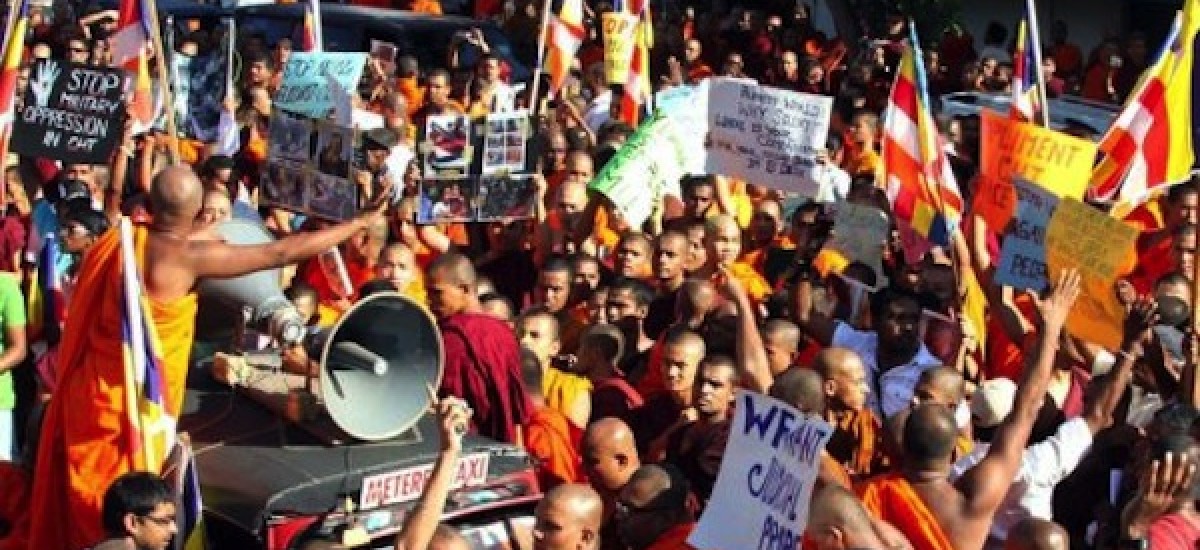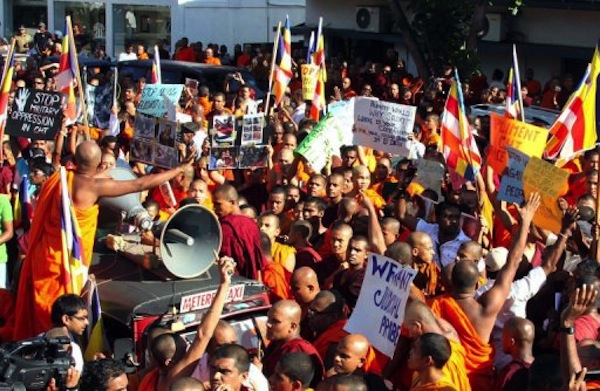Photo by AFP, via Sri Lanka Brief
Since the end of war in 2009, Sri Lanka has become a country full of zealots and patriots singing the song of country first, religion first and race first. Imponderably, the result that reaped due to this zealotry and patriotism is a fragmenting country along religious and racial lines, religions being hijacked by extremists and rising racial discriminations destabilising a once homogenous nation built on centuries of religious, ethnic & social harmony and pluralism.
Sri Lankan society is homogenous though religious and ethnic diversities are present. This is due to the centuries of cohabitation of the Sinhalese, Tamils and Muslims contributed to by cross pollination of values and ethos that homogenised heterogeneous grouping as Sri Lankans. Ethnocentric identifications as prevalent now or identity as homogenous Sri Lankan were non-existent prior to the advent of the colonialists. In the pre-colonial Sri Lanka, identity did not matter for recognition but allegiances in the feudal setup did. Therefore racial or religious identities were not politicised then as of now. Hence we see in history a confluent society of pluralist nature.
The seeds of diversity and social polarisation were first sown by the colonialists as a strategy to divide and rule the colony. An Historical Relation of the Island Ceylon written by Robert Knox published in 1681 is an anthropological study critically identifying cultural, social, religious traits and other dissimilarities and differences of the people of Ceylon and sensitises and highlights the differences between people as conflicting as opposed to identifying similarities and confluences amongst its citizens to engender cohabitation and social harmony.
The colonialists used the science of anthropology as a tool to elicit differences between people and cultivated such differences as elements of identity, power and recognition resulting in producing a fragmented society that competed against each other and conveniently falling prey to the ruse of the colonialists helping to effective divide and rule of Sri Lanka.
During this time patriotic Ceylonese from across the religious, social and ethnic divide spurned such divisions and fought to rid the country of the colonial yoke as a united body. Their struggle to liberate the country was not centred on racial or religious superiority but on the moral high ground of liberating the country for its citizens to live free of colonial fetters. History is replete with examples of how the Sinhalese, Tamil and Muslims fought in unison against colonialism until the colonial masters found amongst Ceylonese compatriots some who became mercenaries working for them, later to be identified as ‘Brown Sahibs’.
During the post colonial period, the Brown Sahibs who took the rein of the country were no different from their colonial master with the exception of their skin colour. They not only inherited a polarised nation but also perpetuated the status quo for their own benefits and manipulated social divisions to keep their grip on power at the cost of society. They failed to embark on a nation building programme of bridging different communities together, instead they set one community against the other in the name of patriotism and nationalism which resulted in the dominant minority Tamil community to start a separatist war that bled the nation for more than three decades.
With the exception of the few hitherto, most of our post colonial patriots have been and remain to be scoundrels who sacrificed the youth of our nation as cannon fodder in a war that benefited the political elites and rarely its citizens. Had they not been scoundrels and true patriots, the post war administration should have done justice to the sacrifices of the armed forces and the citizens from all sides of the conflict. Instead, the victory of war was marketed as a trophy to strengthen the political elites than rebuilding a fractious nation.
Sri Lanka today is more polarised that during the war. During the war, social polarisation was less seeming and the war was often branded as a conflict between the state and non state separatist LTTE where LTTE became a common enemy to all inclusive of certain segments of the Tamil population.
Post war Sri Lanka has become directionless, socio-economic anomalies aggravating, rising unemployment, systemic failure in education, health and other sectors debilitating, corruption and lack of good governance rampant. In this scenario of failing Key Performance Indicators in the country, the ruling elites and the government are answerable to the suffering of the people. The government and the political elites’ lack of capacity and infatuation with power has distanced the people from the centre and leading to political bankruptcy challenging the elites. The political elites, instead of coming with pragmatic solutions to the sufferings of the people are seeking devious means to prop-up their power. This phenomenon of propping-up their power without answering national imperatives was evident since Independence in 1948. One after the other, successive governments, instead of answering the inherent structural problems that confronts the citizens, have used race, religion, language and other differences as a tool to set one against the other thereby effectively preventing the unity of the people for the common good of the nation.
Now in 2013, the state of the Sri Lankan citizens has not changed since 1948, they are yet seeking a land of plenty and freedom with peace and serenity which the political elites promised since 1948. Ups and downs of history since 1948 have come and gone, 71’s & 89’s JVP insurrections, three decades of war against Tamil separatists, the Tsunami and other pegs of history are sufficient enough for us as Sri Lankans to redefine our society, a society free of divisions, parochialism, intolerance and polarisation and a myopic world view of the islanders. Imponderably, the question lurks why has this not happened, why are we divided and why is polarisation current?
We are a sinking society in the name of great civilizations, as most often not, today those who advocate them are scoundrels and not patriots, as the cliché goes, ‘there is no better bush to hide a scoundrel than a Cossack’. Scoundrel in society in the garb of patriots sold religion and race and no doubt very soon, the powers behind the Bodu Bala Sena and Sinhala Ravaya whipping Buddhist extremism will be evident to the people that they are none other than bankrupt political elites using another devious means to extend their power.
Social polarisation advocated by the extremist forces is a threat to the nation; it damages the social ecology grown from time immemorial. Forceful redefinition of society fragments it and renders it unsustainable. Interdependency, mutual trust and free mixing of people builds a viable sustainable society. Isolation, ostracising and discrimination destroy the very foundation of our well matured pluralistic society. The conflicts that ensue as a result of these misadventures cannot be ended by a war; instead it will be mutually assured destruction to all and sundry.
This threat to the Muslim community is a challenge to this nation. This is not from the mainstream Buddhist community that has a time tested relationship with Muslims. It is from purpose made Buddhist extremist groups working as mercenaries to prop up failing political elites, consciously or unconsciously serving foreign interests than the hallowed purpose of protecting Buddhism. Muslims must take note that based on the time tested relationship with the Buddhists in the past, the future can be chalked out together to build this nation free of extremism on all sides. In this time Muslim must extend support to the mainstream society to fight extremism in all its forms and manifestations and work with the patriotic forces in society to build this nation and to get rid of the scoundrels masquerading as patriots.


